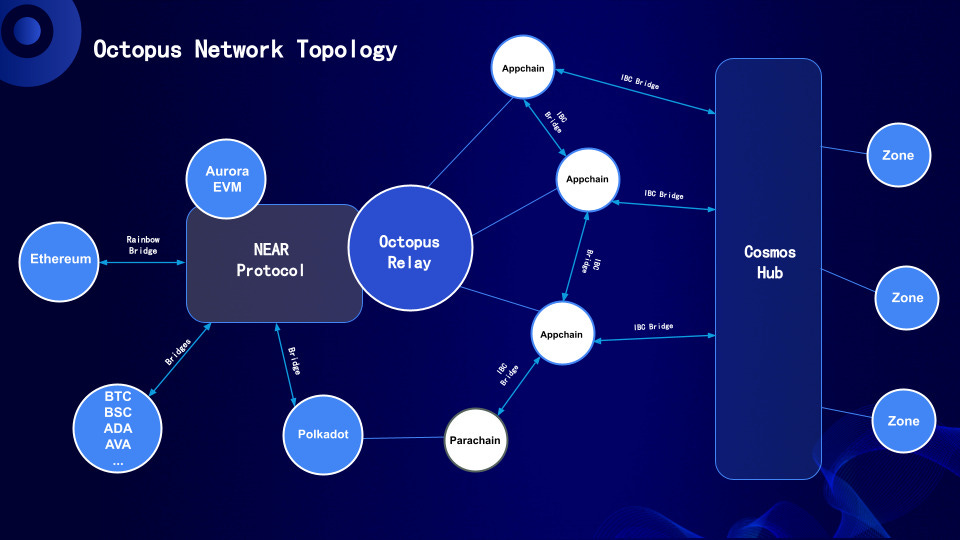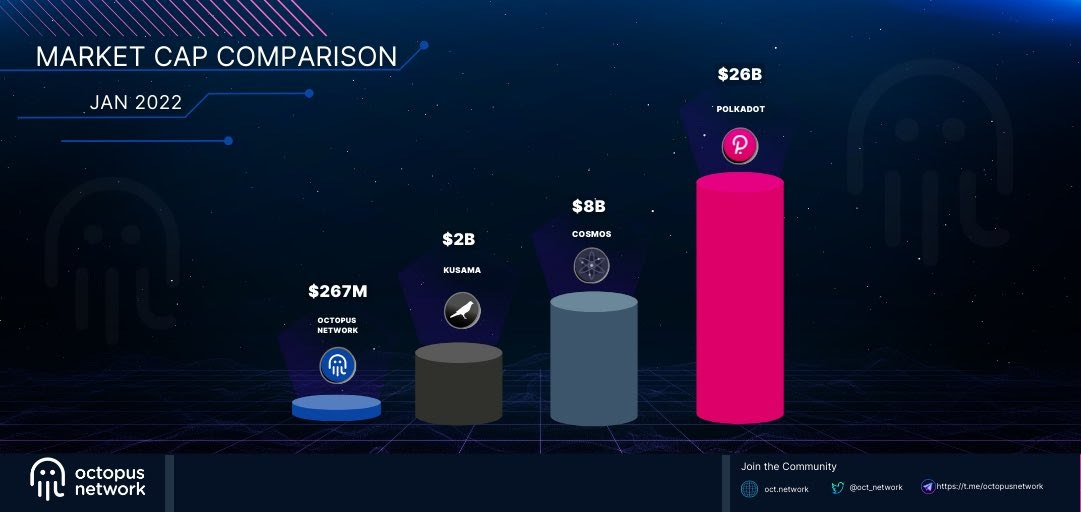The Octopus Network: What it Is and Why It Will Explode in 2022
There’s a growing segment of #CryptoTwitter that believes The Octopus Network is primed to be one of the biggest winners of 2022. But if you’re unfamiliar with the project, the hype can feel a bit misplaced.
So I decided to put together this article. It’s a sort of introduction to The Octopus Network that will cover:
What the network is
How it differs from other platforms that devs can build on
Why it’s likely to grow considerably in 2022 and beyond
What all of that means from an investment standpoint
Let’s get into it.
The problem that got us here
To really understand why The Octopus Network exists and the value it offers, we need a quick history lesson. Lots of this may be familiar to you so feel free to skip ahead if you want.
Ethereum revolutionized the blockchain industry by giving developers smart contract functionality. It’s grown into an all-purpose network of dApps that lets users trustlessly transact with one another in lots of different ways.
But Ethereum is almost unusable in its current state. On a good day, a single transaction might cost you $75-100 to complete. That prices out many people. And it makes it really tough to build apps (like games) that require lots of transactions to function.
Two imperfect solutions
There are currently two main ideas to solve Ethereum’s usability issues. The first is layer 2s. These should make transactions on the Ethereum network more affordable and will definitely have a firm place in the future of blockchain.
The second solution is building a new blockchain from scratch. We saw a bunch of these get popular in 2021, including Solana, Avalanche, and Luna.
The problem with each of these solutions is that neither gives a developer complete control over their technology. Regardless of whether a dev builds on an Ethereum layer 2 or a blockchain like Solana or Avalanche, they have to bend their tech stack around the static requirements of the network.
That means a developer who uses one of these platforms is limited in what they can create. Many won’t be able to bring their true vision to life or optimize their dApp so that it runs as efficiently and effectively as possible if they use one of these platforms.
A third option
In my view, a third option presents the best opportunity for new blockchain developers. This is the multi-chain model that’s been popularized by Cosmos and Polkadot.
If you’re not familiar, the multi-chain model essentially envisions an ecosystem of interoperating blockchains instead of a single blockchain that all devs build on.
You can think of it as something like the internet of blockchains, where every site that you go to is its own blockchain, but they’re all connected and easily accessible from one another.
The benefit of this model is that devs can build blockchains that are optimized for the apps they want to create instead of having to work within the static requirements of an existing chain.
And because there’s a central hub that connects all of these independent chains, devs don’t have to build the entire thing from the ground up – thereby saving a ton of time and money.
Enter the Octopus
Polkadot and Cosmos are currently the two main players in the multi-chain model game. But neither is perfect.
If a developer wants to build on Polkadot, they have to be able to afford the consensus costs of one shard of the network. This could be millions or even tens of millions per year. That severely limits the potential for innovation on the network, since only companies with lots of existing capital (likely from VCs) can afford to play.
Cosmos is also challenging to build on because doing so requires a complex and costly appchain bootstrapping process. Once again, this limits the potential for innovation on the network.
The Octopus Network was designed to solve these problems. It’s a set of smart contracts that will act as a sort of relay between the Near blockchain, Ethereum, Cosmos, Polkadot, and all of the appchains that will be built on The Octopus Network.
What Octopus offers that others don’t
The Octopus Network fills a gap in the multi-chain model that no other product has addressed yet. Its unique combination of affordability, interconnectivity, and customizability should help to facilitate the next wave of web 3 innovation.
Here’s a look at three key things that The Octopus Network does differently.
Affordability with plug and play security
Devs want to be able to customize their blockchain tech to meet the unique needs of their app. But they need to secure their blockchain to do this.
Currently, that means either spending millions every year to secure a Polkadot shard or creating a native token and building a community of stakers who will purchase it in bulk. Both options are too costly and time-consuming for many would-be developers.
The Octopus Network solves this problem by letting devs secure their appchains with the $OCT token instead of having to create their own. So instead of having to build a community of stakers from scratch, a new appchain only needs to appeal to an existing one by offering a slightly higher than average interest rate.
What’s more, a developer doesn’t have to immediately start paying millions per year to secure their network. Instead, they can adjust their security requirements as their appchain grows. This makes it possible to start creating at a price point that is affordable to everyone.
Complete customizability
Developers who use The Octopus Network to secure their appchains are free to create whatever they want. They can create appchains that are highly specialized to meet the unique needs of the app they want to build without having to worry about coming up with their own security solution for that appchain.
In other words, a new developer who uses The Octopus Network gets all of the customization benefits of building on a multi-chain network like Polkadot or Cosmos without the costs.
Interconnectivity
The Octopus Network was built from the ground up to offer as much interconnectivity as possible. Devs who build on it can access Ethereum, Near, and Aurora via Near’s Rainbow Bridge.
Additionally, The Octopus Network is building an out-of-box IBC pallet that will make it super simple for any appchain on the network to connect with any IBC-enabled chain on the Cosmos network.
So, essentially, if you build on The Octopus Network, you can easily connect users of your application with any dApps on Ethereum, Near, Cosmos, Polkadot, and Aurora without having to build that connectivity yourself.
This really opens up the potential for applications developed on Octopus. If it’s easy for users from every popular network to access an Octopus appchain, the pool of potential users for those applications is enormous.
What this means for the network moving forward
The bottom line is that The Octopus Network is a better platform for new developers to build on. It’s easier to get started with a new project on Octopus thanks to its out-of-the-box security, pre-built interconnectivity, and wide-open customizability.
Developers want to create the best version of their vision possible. To do that, they need to build on the right platform. Given all of the unique benefits that The Octopus Network offers, it’s undeniable that many new developers will begin seeing it as the ideal place for their projects.
And as more and more developers build on The Octopus Network, all of those new appchains will need $OCT tokens for security. This should lead to a significant spike in the price of $OCT, as there will only ever be 100 million units of it.
Imagining the value of a fully-functional Octopus Network
So now we’re ready for the fun part. We’ve looked at why The Octopus Network exists, the unique value that it offers developers, and why the price of $OCT should grow in the future. Now it’s time to analyze exactly how much we can expect it to grow.
Points of comparison
The best way to analyze the potential value of a project is to look at the valuations of its competitors. So take a look:
You can see that The Octopus Network is still roughly 10x away from its nearest competitor, Kusama, 40x away from Cosmos, and a whopping 100x away from Polkadot.
To put that into perspective, here’s the price of $OCT at its current circulating supply of ~43 million if it were to equal each of its competitors:
Kusama - $59.88
Cosmos - $266.56
Polkadot - $706.73
That’s a hell of a lot of runway.
The next obvious questions are, how likely is it that The Octopus Network meets each of these thresholds? And when might that occur?
Evaluating Octopus Network’s price
As we start imagining the potential price of $OCT in 2022 and beyond, there are a few things we need to think about.
Macroeconomic conditions
This is perhaps the most important factor in determining the short-to-medium-term price of $OCT. If the crypto market as a whole takes a hit in 2022 (which many think is likely to occur) then $OCT’s growth will likely be muted for most of the year.
But it’s also worth pointing out that we’ve seen $OCT continuously break new ATHs over the past month, even as Bitcoin and Ethereum have been in a steady downtrend. So it’s possible that $OCT could be the rare crypto asset that continues growing in a marketwide pullback.
What will Octopus’ killer app be?
Another factor to consider when evaluating the future price of $OCT is what a killer app for the network might look like. That is, what’s going to get built on Octopus that’s so good people will have to bridge over from other networks to come to check it out.
There’s no obvious answer to this yet. But when that app gets built, that’s when I expect the value of $OCT to start skyrocketing. It could happen this year or it could take some time. Only time will tell.
Twitter hype
Twitter influencers play a huge role in driving up the price of low-cap assets. We’re starting to see some influencers like Ansem (@blknoiz06) tweet about $OCT as a big value play in 2022. I expect that trend to continue picking up steam throughout the year and for the price of $OCT to continue rising as it does.
How much will $OCT be worth this year and in the future?
I wish I knew.
What’s clear to me is that, from a technology standpoint, The Octopus Network offers something that none of its competitors do. It provides a unique combination of affordability, interconnectivity, and customizability that should appeal greatly to the next wave of developers.
I also think that as the $OCT token starts getting more and more hype on Twitter, more and more developers and users will be introduced to the network. So even if The Octopus Network’s killer app isn’t already being built, it will likely be started in the near future.
I’m looking at this as a long-term investment, rather than a short-term trade. So while I think it’s highly likely that $OCT has a multi-billion dollar valuation by the end of 2022, nothing is guaranteed in this macro environment.
But the bottom line is that The Octopus Network is easier and more affordable to build on than Polkadot and Cosmos, while also providing more interconnectivity than either. So I absolutely see a future (maybe near, maybe distant) in which $OCT is an 11-figure asset.
That would be a nearly 50x increase from current prices.





